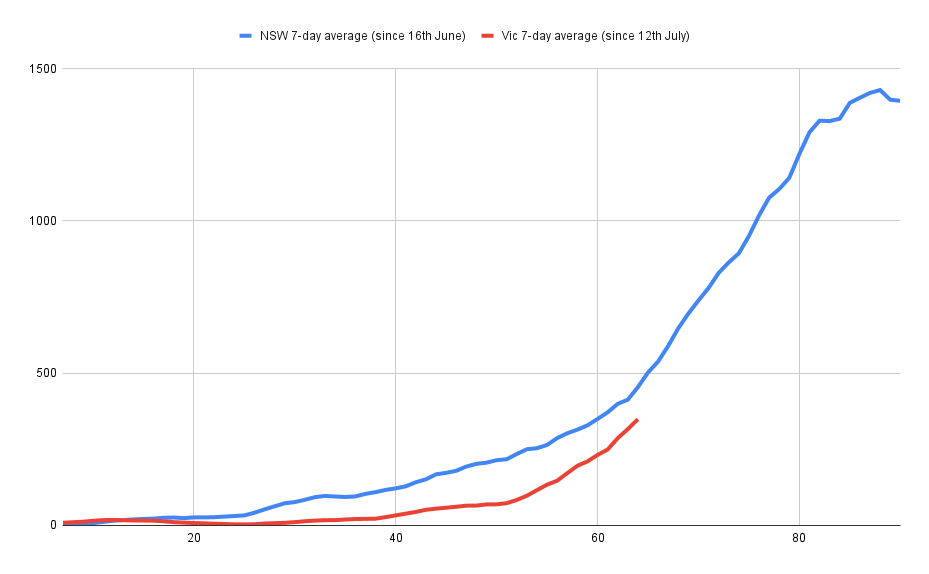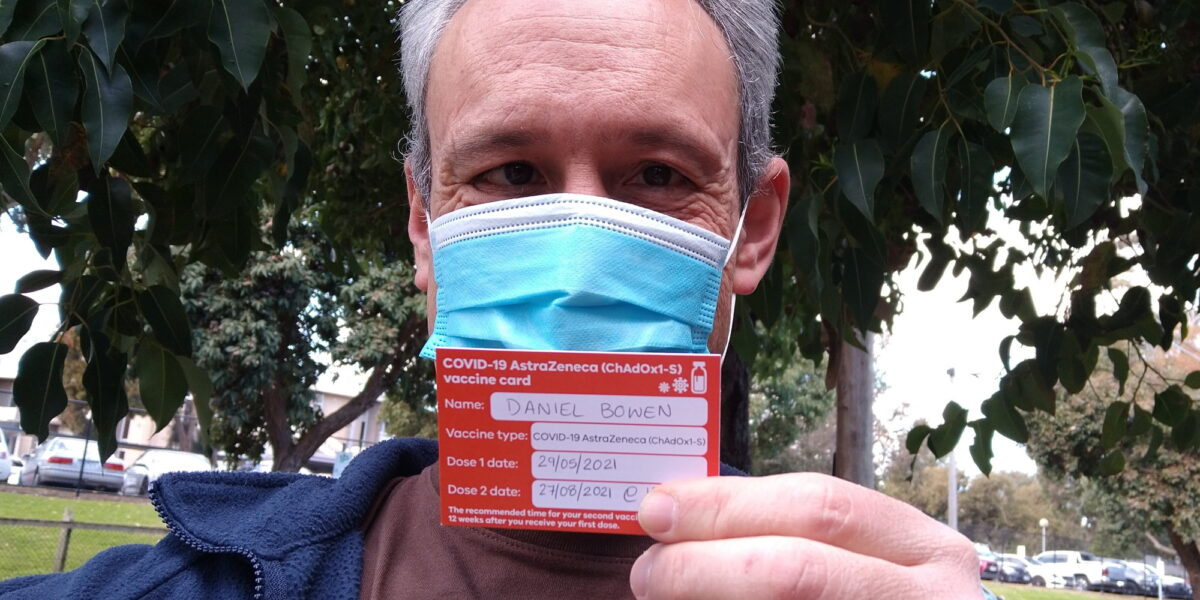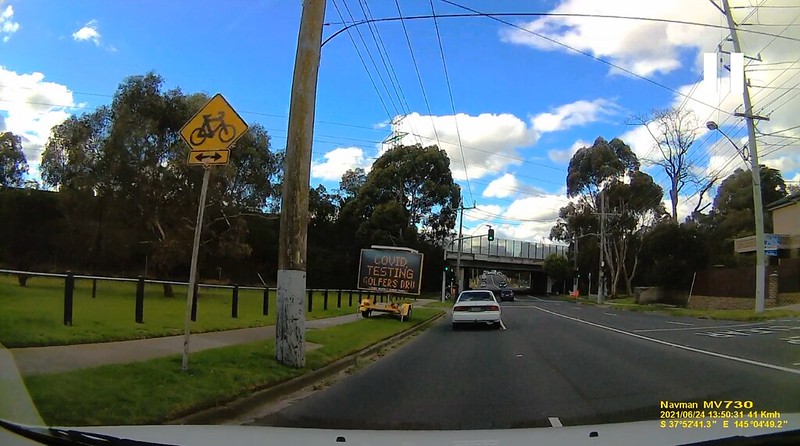With spring now upon us, we’re now almost 18 months into this.
Last month I had another birthday in lockdown. A nice dinner and a video call with family made up for it. I don’t enjoy being in lockdown, but it seems to be the least bad way to keep the virus under control while everybody gets vaccinated.
At first, watching Sydney’s second wave was, to some Victorians, myself included, somewhat distressing. It’s not a competition, but we went through genuine pain last year, and to see the NSW leadership seemingly stubbornly ignoring our mistakes is upsetting.
It seemed like every other state apparently was able to learn from Victoria’s 2020 experience: lock down hard, lock down early. (This ABC article has a good interactive chart comparing state lockdown times.)
But now – despite my best hopes – Vic seems to be heading the same way as NSW. And we seem to be catching up – the Vic 7-day average for cases today (13th September, outbreak day 64) is 348. NSW got there on day 60 (14th August).

Why is it spreading despite lockdown?
There are some people in big intergenerational households who can’t work remotely – they have to attend work in person in essential jobs.
And frustratingly, there are those who simply won’t follow the rules.
I had a sense that traffic levels were higher than during the theoretically similar lockdown in 2020.
It turns out I was correct – one data point put traffic at around 61% of normal, compared to 51% last year. Other data shows it is higher in some areas than others.
While the virus continues to spread, the key difference from last year is that many people, particularly in aged care, have been vaccinated. Treatment is also better. Which means thankfully, hospitalisations and deaths are not as common.
But meanwhile some other vulnerable groups such as indigenous people have not had their vaccinations, which is a disaster waiting to happen. I really hope authorities are doing everything they can.
Fully vaxxed
I last got tested in June due to mild symptoms. The negative result came back in 16 hours. It’s interesting to see the cost. You’ll find it in your MyGov Medicare account. A test costs (for the government, not for individuals) about $93.
In contrast, a vaccination dose costs $31. My first dose was in May, the second was in August. Two doses of the Astra Zenica vaccine – just under 12 weeks apart.
I know some people don’t feel so good after the AZ jab, but happily the only thing I’m feeling 24 hours later is a slightly sore upper arm where the needle went in.💉💪 pic.twitter.com/KKZDHG9AJB
— Daniel Bowen (@danielbowen) May 30, 2021
There is minor risk of side-effects. All I had was a slightly sore arm for a few days after both doses, and a minor headache after the second. It’s just a relief to be fully vaccinated.
After months of the vaccine rollout being a complete mess, it’s finally making good progress, and most of my friends and family have also got one or both of their doses.
That’s the silver lining. I know I’m not the only person feeling drained and dispirited by all this.
The way out
Given the Delta strain is so infectious, vaccination seems to be the only way out of this mess now.
There’s still the question of the long term impacts on society.
I’m particularly interested in the transport network impacts of course.
The longer office workers are at home, the less likely it is they’ll go back to offices fulltime. And that’s going to have huge ongoing impacts on things like public transport patronage. I’m planning another blog on this soon.
Stay safe out there, folks. And get vaccinated if you can.


6 replies on “18 months in”
Into that statistical mix throw in people like us whose car would normally sit for a week at a time unused but under lock down we stop using public transport so our car usage rises greatly.
Bear in mind that NSW contains 1/3 of Australia’s population, is the country’s major point of entry and has had the largest quarantine task, often on behalf of other states (two of which refuse to pay for that). So its task in managing the virus is larger than Victoria’s and vastly larger than that of any other state or territory. I think NSW and Victoria have worked quite well together in spite of many partisan people trying to turn it into an interstate rivalry. Bear in mind also that Sydney’s second wave last year was introduced by Victorians, so it has moved both ways between the two states at different times.
I watched how the Delta variant took off in India and it doesn’t surprise me at all that it’s so bad in Australia. It was always going to be a hard one to control and it is severely testing even the excellent NSW health system that had coped very well prior to this. The main reason that WA and Queensland have been so severe in their responses is that they’re terrified that their very under-resourced and neglected health systems will collapse if there was a major outbreak. Most significantly in terms of the worst outcome for people, Victoria has had 824 deaths (about 80% of Australia’s total) while NSW has had 238. This is obviously the statistic that matters most to and has the greatest potential impact on most people. Ultimately living through it to rebuild another day, in spite of undergoing a lot of inconvenience and economic impact along the way, is really the most important thing. Dying from it is simply a disaster on both a personal and national level. We need to keep a sense of perspective about that.
Finally, the worst thing I’ve seen in the whole episode is the breakdown in national unity brought about by two very machiavellian Labor Premiers who can’t pass up the opportunity to play a political game with it in order to win elections, while disguising the truth about their health systems from their electrorates. That’s been simply disgusting. To its credit, Victoria has risen above that and I hope Victorians will continue to resist the temptation to score points out of it. As they say, we are all in this together.
Now, I need to ask you, how did you get that card?
I got my two Phizer jabs at my local GP, who told me, the only way to get anything, is to get into Medicare via MyGov, where you can download a document. The only thing is, you can only link the Medicare to your MyGov, if you know the exact date of your last doctors appointment. I cant.
The irony here is, I booked an appointment with my doctor on the same day as my second jab, 15 minutes before while getting my first jab, as I have some medical needs to talk about. When I turned up, I was told, you can only talk your doctor face to face, if, you are there to talk about the vaccine jab. all other purposes are banned.
The last I hear, NSW got past the 78.5% of first jabs, meaning they are not far off their 80% mark.
As for letting the virus in, our Prime Minister, had put a ban on the entry of people from India, as it was right in the height of their Delta strain pandemic. However, he caved in, as a direct result of, pressure from another political party. It is for this backdown, and this alone, that we are suffering under the lockdowns as we are doing today.
Jim, Daniel’s card is not proof of vaccination.
It’s mostly a reminder for the time he is booked for his second dose (while also detailing which vaccine he had a first dose of, the batch number, and the date it was adminstered).
It doesn’t record whether or not he showed up for the second dose. Even if it did, it’s not physically or digitally signed by anyone to authenicate it.
This is why people will need to get a proper vaccination certificate from Medicare/MyGov if they want proper proof of vaccination.
It’s quite easy to do: https://www.servicesaustralia.gov.au/individuals/subjects/getting-help-during-coronavirus-covid-19/covid-19-vaccinations/how-get-proof-your-covid-19-vaccinations
You will be able to use the date of your second dose as the date of your last doctor’s appointment. You GP will have bulk billed you for adminstering the vaccine that day, and this will be the info that the ap will use to verify you.
I fear the whole thing starting again when it comes time for booster shots in a few months… because the effects of the vaccines slowly wane over time.
[…] when you think you’ve got a handle on things… pandemic, lockdown, city protests… another curveball comes at […]